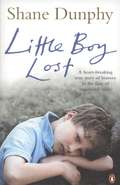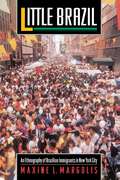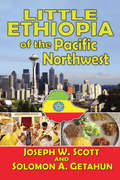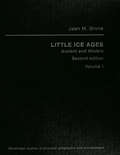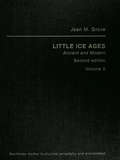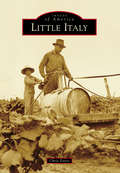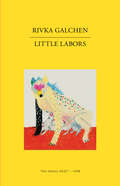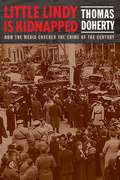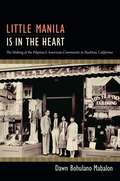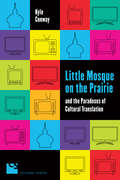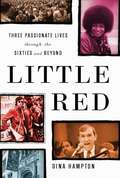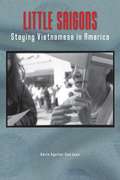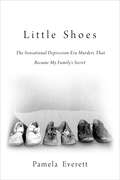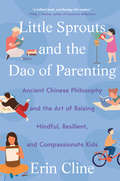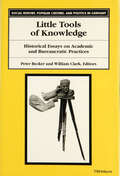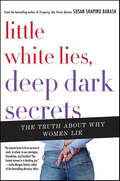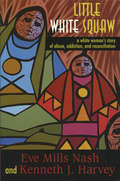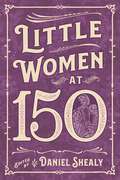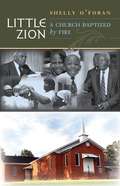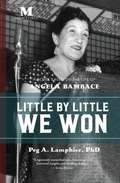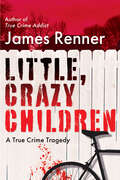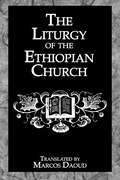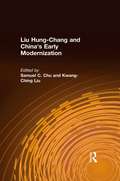- Table View
- List View
Little Boy Lost
by Shane DunphyLittle Boy Lost is the story of Dominic's brave battle to face up to betrayal and show - one more time - that he is a survivor.
Little Brazil: An Ethnography of Brazilian Immigrants in New York City
by Maxine L. MargolisWalking west on 46th Street in Manhattan, just three blocks from Rockefeller Center, one passes Brazilian restaurants, the office of New York's Brazilian newspaper, a Brazilian travel agency, a business that sends remittances and wires flowers to Brazil, and a store that sells Brazilian food products, magazines, newspapers, videos, and tapes. These businesses are the tip of an ethnic iceberg, an unseen minority estimated to number some 80,000 to 100,000 Brazilians in the New York metropolitan area alone. Despite their numbers, the lives of these people remain largely hidden to scholars and the public alike. Now Maxine L. Margolis remedies this neglect with a fascinating and accessible account of the lives of New York's Brazilians.Showing that these immigrants belie American stereotypes, Margolis reveals that they are largely from the middle strata of Brazilian society: many, in fact, have university educations. Not driven by dire poverty or political repression, they are fleeing from chaotic economic conditions that prevent them from maintaining amiddle-class standard of living in Brazil. But despite their class origin and education, with little English and no work papers, many are forced to take menial jobs after their arrival in the United States. Little Brazil is not an insentient statistical portrait of this population writ large, but a nuanced account that captures what it is like to be a new immigrant in this most cosmopolitan of world cities.
Little Ethiopia of the Pacific Northwest
by Joseph W. ScottLittle Ethiopia of the Pacific Northwest tells the story of the Ethiopian community in Seattle. The community began with approximately two dozen college students who came to the city during the Ethiopian revolution of 1974. These sojourning students earned college and university degrees, but were unable to return home to use them to modernize the developing nation. These stranded students became pioneers who built a micro-community in inner-city Seattle.Providing background with an analysis of Seattle's geographic, demographic, social, and economic challenges, this volume studies the students who became asylum seekers; their falls in position, power, prestige; and the income of these elite and non-elite settlers. The authors analyze examples of those who became entrepreneurs and the ingenuity and determination they employed to start successful businesses.The authors examine the challenges imposed on them by a school system that assigned their children to grade levels according to age rather than knowledge. They explore how the American welfare system worked in practice and explain how and why Ethiopians die young in Seattle. This fascinating study will be of interest to sociologists, ethnographers, and regional analysts.
Little History of Archaeology (Little Histories)
by Brian FaganThe thrilling history of archaeological adventure, with tales of danger, debate, audacious explorers, and astonishing discoveries around the globe What is archaeology? The word may bring to mind images of golden pharaohs and lost civilizations, or Neanderthal skulls and Ice Age cave art. Archaeology is all of these, but also far more: the only science to encompass the entire span of human history—more than three million years! This Little History tells the riveting stories of some of the great archaeologists and their amazing discoveries around the globe: ancient Egyptian tombs, Mayan ruins, the first colonial settlements at Jamestown, mysterious Stonehenge, the incredibly preserved Pompeii, and many, many more. In forty brief, exciting chapters, the book recounts archaeology’s development from its eighteenth-century origins to its twenty-first-century technological advances, including remote sensing capabilities and satellite imagery techniques that have revolutionized the field. Shining light on the most intriguing events in the history of the field, this absolutely up-to-date book illuminates archaeology’s controversies, discoveries, heroes and scoundrels, global sites, and newest methods for curious readers of every age.
Little Ice Ages Vol1 Ed2: Ancient And Modern (Routledge Studies In Physical Geography Ser. #Vol. 5)
by Jean M GroveFirst published in 2004. Since The Little Ice Age was published in 1988, interest in climatic history has grown rapidly and research in the area has flourished. A vast amount of new data has become available from sources such as ice cores, speleothems and tree rings. The picture that we have of past climates and glacier oscillations has extended further into the past and has become more detailed. However, the knowledge of climate change on the decennial and centennial timescale, to which glacier history can contribute, is scarce and is in demand when attempting to predict future change, especially with regard to global warming. New chapters and material have been included throughout the book, which tend to confirm and elaborate on the conclusions of the first edition. The glacial evidence has been presented in the context of the oceanographic and icecap studies that have provided such exciting results. Little Ice Ages is structured in three parts: • Part 1 details the evidence for glacier variations in the last thousand years in different parts of the world and the associated climatic fluctuations. • Part 2 brings together the evidence for the timing of glacier variations in the course of the Holocene. • Part 3 views the Holocene record in a longer time context, especially as it appears in ice cores, and goes on to consider the likely causes of climatic variability on a Little Ice Age timescale and some of its physical, biological and human consequences. It becomes apparent in Little Ice Ages that the glacier record provides a valuable indication of the nature of climatic fluctuations on the land areas of the globe. The record points to periods of cooling which were more numerous and less continuous than was believed to be the case twenty years ago. There appears to be no single explanation for the variability. Volcanism, solar variability and ocean currents have all played their parts and prediction continues to present many problems. Some authorities have thrown doubt on the existence of the Little Ice Age, but Little Ice Ages makes the case for a climatic sequence that can usefully be called the Little Ice Age and which had predecessors occurring at intervals of several centuries throughout much of the last 10,000 years.
Little Ice Ages Vol2 Ed2: Ancient And Modern (Routledge Studies In Physical Geography Ser. #Vol. 5)
by Jean M GroveFirst Published in 2004. Routledge is an imprint of Taylor & Francis, an informa company.
Little Italy
by Chris DorerOriginally called Alta Villa (the "high place"), Little Italy was settled in 1915 by a group of northern Italian immigrants who came to Arkansas looking for an opportunity to achieve the American dream. Though smaller than other Italian colonies in the state, like Tontitown or Lake Village, Little Italy's centralized location and skilled winemakers created the perfect atmosphere for a Prohibition-era oasis where central Arkansans could purchase clean, safe alcohol at a time when thousands throughout the nation had died because of poisonous, alcoholic brews. Recognizing the value of this operation, regional politicians allowed the residents of Little Italy to continue producing wine and cognac, thus establishing the community as a regional curiosity and a popular weekend travel destination.
Little Labors
by Rivka GalchenRivka Galchen's Little Labors is a droll and dazzling compendium of observations, stories, lists, and brief essays about babies and literature Sei Shonagon's Pillow Book--a key inspiration for Rivka Galchen's new book--contains a list of "Things That Make One Nervous." And wouldn't the blessed event top almost anyone's list? Little Labors is a slanted, enchanted literary miscellany. Varying in length from just a sentence or paragraph to a several-page story or essay, Galchen's puzzle pieces assemble into a shining, unpredictable, mordant picture of the ordinary-extraordinary nature of babies and literature. Anecdotal or analytic, each part opens up an odd and tender world of wonder. The 47 Ronin; the black magic of maternal love; babies morphing from pumas to chickens; the quasi-repellent concept of "women writers"; origami-ophilia in Oklahoma as a gateway drug to a lifelong obsession with Japan; discussions of favorite passages from the Heian masterpieces Genji and The Pillow Book; the frightening prevalence of orange as today's new chic color for baby gifts; Frankenstein as a sort of baby; babies gold mines; babies as tiny Godzillas ... Little Labors-atomized and exploratory, conceptually byzantine and freshly forthright-delights.
Little Lindy Is Kidnapped: How the Media Covered the Crime of the Century
by Thomas DohertyThe biggest crime story in American history began on the night of March 1, 1932, when the twenty-month-old son of Charles and Anne Lindbergh was snatched from his crib in Hopewell, New Jersey. The news shocked a nation enthralled with the aviator, the first person to fly solo nonstop across the Atlantic. American law enforcement marshalled all its resources to return “Little Lindy” to the arms of his parents—and perhaps even more energized were the legions of journalists catering to a public whose appetite for Lindbergh news was insatiable.In Little Lindy Is Kidnapped, Thomas Doherty offers a lively and comprehensive cultural history of the media coverage of the abduction and its aftermath. Beginning with Lindbergh’s ascent to fame and proceeding through the trial and execution of the accused kidnapper, Doherty traces how newspapers, radio, and newsreels reported on what was dubbed the “crime of the century.” He casts the affair as a transformative moment for American journalism, analyzing how the case presented new challenges and opportunities for each branch of the media in the days before the rise of television. Coverage of the Lindbergh story, Doherty reveals, set the template for the way the media would treat breaking news ever after. An engrossing account of an endlessly fascinating case, Little Lindy Is Kidnapped sheds new light on an enduring quality of journalism ever since: the media’s eye on a crucial part of the story—itself.
Little Manila Is in the Heart: The Making of the Filipina/o American Community in Stockton, California
by Mabalon Dawn BohulanoIn the early twentieth century--not long after 1898, when the United States claimed the Philippines as an American colony--Filipinas/os became a vital part of the agricultural economy of California's fertile San Joaquin Delta. In downtown Stockton, they created Little Manila, a vibrant community of hotels, pool halls, dance halls, restaurants, grocery stores, churches, union halls, and barbershops. Little Manila was home to the largest community of Filipinas/os outside of the Philippines until the neighborhood was decimated by urban redevelopment in the 1960s. Narrating a history spanning much of the twentieth century, Dawn Bohulano Mabalon traces the growth of Stockton's Filipina/o American community, the birth and eventual destruction of Little Manila, and recent efforts to remember and preserve it. Mabalon draws on oral histories, newspapers, photographs, personal archives, and her own family's history in Stockton. She reveals how Filipina/o immigrants created a community and ethnic culture shaped by their identities as colonial subjects of the United States, their racialization in Stockton as brown people, and their collective experiences in the fields and in the Little Manila neighborhood. In the process, Mabalon places Filipinas/os at the center of the development of California agriculture and the urban West.
Little Mosque on the Prairie and the Paradoxes of Cultural Translation
by Kyle ConwayIn 2007, Little Mosque on the Prairie premiered on the Canadian Broadcasting Corporation network. It told the story of a mosque community that worshiped in the basement of an Anglican church. It was a bona fide hit, running for six seasons and playing on networks all over the world. Kyle Conway’s textual analysis and in-depth research, including interviews from the show’s creator, executive producers, writers, and CBC executives, reveals the many ways Muslims have and have not been integrated into North American television. Despite a desire to showcase the diversity of Muslims in Canada, the makers of Little Mosque had to erase visible signs of difference in order to reach a broad audience. This paradox of ‘saleable diversity’ challenges conventional ideas about the ways in which sitcoms integrate minorities into the mainstream.
Little Red: Three Passionate Lives through the Sixties and Beyond
by Dina HamptonIn the early 1960s, a remarkable crop of students graduated from a small New York City school renowned for progressive pedagogy and left-wing politics: Little Red School House and Elisabeth Irwin High School. These young people entered college at the peak of the transformative era we now call The Sixties, and would go on to impact the course of United States history for the next half century. Among them were Angela Davis, the brilliant, stunning African American Communist and academic who became the face of the Black Power movement; Tom Hurwitz, Students for a Democratic Society (SDS) activist and cinematographer who played a key role in the occupation of Columbia University; and Elliott Abrams, who rebelled against the leftist political orthodoxies of the school and of the times, and ultimately played key roles in the Reagan administration, the George W. Bush administrations and the neoconservative movement.In Little Red, based on extensive original interviews and archival research, Dina Hampton tells the compelling, interwoven life stories of these three schoolmates. Their tumultuous, divergent, public and private paths wind through the seminal events and political conflicts of recent American history, from the civil rights movement to the Vietnam War; the Summer of Love to the feminist uprising; Iran-Contra to Occupy Wall Street. As they pursue political ends, each of their lives will be shaped by events, relationships and social changes they never imagined. Their successes and setbacks will resonate with anyone who has struggled to reconcile the utopian goals of The Sixties-or of youth itself-with the realities of day-to-day life in the world as it is. Today, a new generation is taking to the streets, galvanized by controversial wars and social and economic inequities as troubling as those we faced in the 1960s. The stories of Angela, Tom and Elliott serve as both road map and cautionary tale for anyone engaged in that most American of acts-trying to perfect the world.
Little Saigons: Staying Vietnamese in America
by Karin Aguilar-San JuanKarin Aguilar-San Juan examines the contradictions of Vietnamese American community and identity in two emblematic yet different locales: Little Saigon in suburban Orange County, California (widely described as the capital of Vietnamese America) and the urban "Vietnamese town" of Fields Corner in Boston, Massachusetts. Their distinctive qualities challenge assumptions about identity and space, growth amid globalization, and processes of Americanization. <P><P> With a comparative and race-cognizant approach, Aguilar-San Juan shows how places like Little Saigon and Fields Corner are sites for the simultaneous preservation and redefinition of Vietnamese identity. Intervening in debates about race, ethnicity, multiculturalism, and suburbanization as a form of assimilation, this work elaborates on the significance of place as an integral element of community building and its role in defining Vietnamese American-ness. <P><P> Staying Vietnamese, according to Aguilar-San Juan, is not about replicating life in Viet Nam. Rather, it involves moving toward a state of equilibrium that, though always in flux, allows refugees, immigrants, and their U.S.-born offspring to recalibrate their sense of self in order to become Vietnamese anew in places far from their presumed geographic home.
Little Shoes: The Sensational Depression-Era Murders That Became My Family's Secret
by Pamela EverettIn the summer of 1937, with the Depression deep and World War II looming, a California triple murder stunned an already grim nation. After a frantic week-long manhunt for the killer, a suspect emerged, and his sensational trial captivated audiences from coast to coast. Justice was swift, and the condemned man was buried away with the horrifying story. But decades later, Pamela Everett, a lawyer and former journalist, starts digging, following up a cryptic comment her father once made about a tragedy in their past. Her journey is uniquely personal as she uncovers her family's secret history, but the investigation quickly takes unexpected turns into her professional wheelhouse. Everett unearths a truly historic legal case that included one of the earliest criminal profiles in the United States, the genesis of modern sex offender laws, and the last man sentenced to hang in California. Digging deeper and drawing on her experience with wrongful convictions, Everett then raises detailed and haunting questions about whether the authorities got the right man. Having revived the case to its rightful place in history, she leaves us with enduring concerns about the death penalty then and now. A journey chronicled through the mind of a lawyer and from the heart of a daughter, Little Shoes is both a captivating true crime story and a profoundly personal account of one family's struggle to cope with tragedy through the generations.
Little Sprouts and the Dao of Parenting: Ancient Chinese Philosophy And The Art Of Raising Mindful, Resilient, And Compassionate Kids
by Erin ClineA philosopher and mother mines classic Daoist and Confucian texts of Chinese philosophy for wisdom relevant to today’s parents. The ancient Chinese philosopher Mencius compared children to tender sprouts, shaped by soil, sunlight, water, and, importantly, the efforts of patient farmers and gardeners. At times children require our protection, other times we must take a step back and allow them to grow. Like sprouts, a child’s character, tendencies, virtues, and vices are at once observable and ever-changing. A practical parenting manual, philosophical reflection on the relationship between parent and child, and necessary response to modern stereotypes of Eastern parenting, Little Sprouts and the Dao of Parenting reconsiders cultural definitions of success and explores how we might support and nourish young people. Engaging deeply with foundational Daoist and Confucian thinkers, Georgetown philosopher Erin Cline offers accessible, provocative musings on key parenting issues. She reveals how ancient Chinese philosophers encourage surprisingly modern values—a love of nature and of learning, mindfulness in everyday interactions, an embrace of disabilities and diversity, and the power of performing rituals with reflection—and relates these to concrete parenting practices, whether celebrating special occasions or finding a child’s unique talents and gifts. Little Sprouts shows how—through the nurturing efforts of parents, grandparents, aunts, uncles, friends, and teachers—we can strengthen innate virtues of compassion, generosity, and individuality in our own tender sprouts. With an engaging and intuitive approach, Cline offers a balanced philosophy that helps us grow into better parents of joyful, fulfilled children.
Little Tools of Knowledge: Historical Essays on Academic and Bureaucratic Practices (Social History, Popular Culture, And Politics In Germany)
by Peter Becker and William ClarkThis volume brings historians of science and social historians together to consider the role of "little tools"--such as tables, reports, questionnaires, dossiers, index cards--in establishing academic and bureaucratic claims to authority and objectivity. From at least the eighteenth century onward, our science and society have been planned, surveyed, examined, and judged according to particular techniques of collecting and storing knowledge. Recently, the seemingly self-evident nature of these mundane epistemic and administrative tools, as well as the prose in which they are cast, has demanded historical examination. The essays gathered here, arranged in chronological order by subject from the late seventeenth to the late twentieth century, involve close readings of primary texts and analyses of academic and bureaucratic practices as parts of material culture. The first few essays, on the early modern period, largely point to the existence of a "juridico-theological" framework for establishing authority. Later essays demonstrate the eclipse of the role of authority per se in the modern period and the emergence of the notion of "objectivity." Most of the essays here concern the German cultural space as among the best exemplars of the academic and bureaucratic practices described above. The introduction to the volume, however, is framed at a general level; the closing essays also extend the analyses beyond Germany to broader considerations on authority and objectivity in historical practice. The volume will interest scholars of European history and German studies as well as historians of science. Peter Becker is Professor of Central European History, European University Institute. William Clark is Lecturer in History and Philosophy of Science, Cambridge University.
Little White Lies, Deep Dark Secrets: The Truth About Why Women Lie
by Susan Shapiro BarashFrom the bestselling author of Tripping the Prom Queen comes a fascinating and provocative look at the reasons behind female deception. Little White Lies, Deep Dark Secrets reveals how society doles out mixed messages to women, fostering the lies they tell. Among the liars are:•A woman who shoplifts, and has it "down to a science"•A woman who tells her husband she is working late in order to be with her lover•A woman who lies about her children's achievements to her friends•A woman who pretends her husband is doing well when they are going broke•A woman who has covered up her husband's emotional abuse for years•A woman whose secret is her misery in being a stay-at-home mom in suburbia•A woman who lies about loving her partner, deciding it's better to stay than be alone•And many other secrets and deceptionsHonest and even outrageous, Susan Shapiro Barash is fast becoming the author who explores issues that are important to women—issues that they are loath to talk about . . . until now.
Little White Squaw: A White Woman's Story of Abuse, Addiction, and Reconciliation
by Kenneth J. Harvey Eve Mills NashI was only six when I suspected my skin might be the wrong colour... Born female on the wrong side of the tracks, Eve Mills Nash, with the help of co-author Kenneth J. Harvey, tells a hard-hitting tale of a lifelong fascination with men of a darker hue. From early childhood, Nash knew it was "something to do with what was inside the bottles" that encouraged the groping male fingers that casually abused her during her parents' drunken parties. She soon discovered that the wine remnants in the revellers' discarded cups would numb her pain. Nash's fortuneteller grandmother predicted a future of violence for her, starting as a teenager with her marriage to first husband Stan, an Ontario Mohawk. What Nash's grandmother didn't prophesize was the drunken binges and revolving door of unstable partners that traumatized her children, left her suicidal, and convinced her she was a failure as a mother after her eldest daughter became a cocaine addict. Harrowing yet life-affirming, this blistering account of life on the cusp of New Brunswick's Native community sees the Little White Squaw and her children balance precariously between two seemingly irreconcilable cultures and colours.
Little Women at 150 (Children's Literature Association Series)
by Daniel ShealyContributions by Beverly Lyon Clark, Christine Doyle, Gregory Eiselein, John Matteson, Joel Myerson, Sandra Harbert Petrulionis, Anne K. Phillips, Daniel Shealy, and Roberta Seelinger Trites As the golden age of children’s literature dawned in America in the mid-1860s, Louisa May Alcott’s Little Women, a work that many scholars view as one of the first realistic novels for young people, soon became a classic. Never out of print, Alcott’s tale of four sisters growing up in nineteenth-century New England has been published in more than fifty countries around the world. Over the century and a half since its publication, the novel has grown into a cherished book for girls and boys alike. Readers as diverse as Carson McCullers, Gloria Steinem, Theodore Roosevelt, Patti Smith, and J. K. Rowling have declared it a favorite. Little Women at 150, a collection of eight original essays by scholars whose research and writings over the past twenty years have helped elevate Alcott’s reputation in the academic community, examines anew the enduring popularity of the novel and explores the myriad complexities of Alcott’s most famous work. Examining key issues about philanthropy, class, feminism, Marxism, Transcendentalism, canon formation, domestic labor, marriage, and Australian literature, Little Women at 150 presents new perspectives on one of the United States’ most enduring novels. A historical and critical introduction discusses the creation and publication of the novel, briefly traces the scholarly critical response, and demonstrates how these new essays show us that Little Women and its illustrations still have riches to reveal to its readers in the twenty-first century.
Little Zion
by Shelly O'ForanThe arson attacks in early 2006 on a number of small Baptist churches in rural Alabama recalled the rash of burnings at dozens of predominantly black houses of worship in the South during the mid-1990s. One of the churches struck by probable arson in 1996 was Little Zion Baptist Church in Boligee, Alabama. This book draws on the voices and memories of church members to share a previously undocumented history of Little Zion, from its beginnings as a brush arbor around the time of emancipation, to its key role in the civil rights movement, to its burning and rebuilding with the help of volunteers from around the world.Folklorist Shelly O'Foran, a Quaker who went to Boligee as a volunteer in the church rebuilding effort, describes Little Zion as always having been much more than the building itself. She shows how the spiritual and social traditions that the residents of Boligee practice and teach their children have assured the continued vitality of the church and community. Through thoughtful fieldwork and presentation, Little Zion also explores the power of oral narrative to promote understanding between those inside and outside the church community. Illustrated with historical and contemporary photographs, this volume is both a celebration of Little Zion's history and an invitation to share in its long life story.
Little by Little We Won: A Novel Based on the Life of Angela Bambace
by Peg A. LamphierWomen marched for equal pay, the President of the United States advocated an anti-immigration policy, and the income gap between the rich and poor continued to grow. And it was just the beginning of the 20th century. As a girl growing up in Italian Harlem, Angela Bambace needed answers. How could it be acceptable for women not to earn equal pay for equal work? Why were immigrants relegated to the factory jobs no one else would take and working under such dangerous and inhumane conditions? And why were the businessmen at the top getting richer and richer while the poor who worked for them struggled to provide for their own families? How could any of this be okay? But perhaps Angela's most consequential question was If not me, then who? Born to a father and married to a man who both believed a woman's place was in the home, Angela Bambace defied her family and social expectations to lead a labor union--organizing women's marches, strikes, and protests "to build a better world, a better place for everybody." Today, Angela's story might be more significant than ever as others continue her fight and call to action.
Little, Crazy Children: A True Crime Tragedy of Lost Innocence
by James RennerA new true-crime book from the acclaimed author of TRUE CRIME ADDICT and creator/host of the podcasts True Crime This Week and The Philosophy of Crime! James Renner explores the unsolved murder of 16-year-old Lisa Pruett in the real-life town of the bestselling novel Little Fires Everywhere in a painstakingly researched account of a senseless and heartbreaking tragedy and the people who were pulled into its aftermath. In September of 1990, in the Cleveland suburb of Shaker Heights, sixteen-year-old Lisa Pruett, a poetry lover and member of a church youth group, was on her way to a midnight tryst with her boyfriend, when she was viciously stabbed to death only thirty feet from the boy&’s home. The murder cast a palpable gloom over the upscale community and sparked accusations, theories, and rumors among Lisa&’s friends and peers. Together they wove a damning narrative that circled back to a likely suspect: &“weird&” high school outcast Kevin Young. Without a shred of evidence the teen was arrested, charged, and tried for the crime. His eventual acquittal didn&’t squelch the anger and outrage among those who believed that Kevin got away with murder. With a fresh perspective and painstaking research culled from police files, court records, transcripts, uncollected evidence, and new interviews, James Renner reconstructs the events leading up to and following that heartbreaking night. What emerges is a portrait of a community seething with dark undercurrents—its single-minded authorities, protective status-conscious parents, and the deeply peer-pressured teens within Lisa&’s circle. Who had the capacity for such unchecked violence? What monsters still lurk in the dark? After more than thirty years, questions like these continue to fester among the community of Shaker Heights, Ohio, still deeply scarred by wounds that remain hidden, unspoken, and unhealed.
Liturgy Ethiopian Church
by DaoudFirst published in 2005. Routledge is an imprint of Taylor & Francis, an informa company.
Liturgy Ethiopian Church
by Marcos DaoudFirst published in 2005. Originally, the Ethiopian Church received fourteen Anaphora’s from the Church of Egypt, yet at the time of publication, only three of them could be accounted for- that of St. Cyril, St. Gregory and St. Basil. Marcos Daoud has therefore devoted this work to the English translation of the remaining three.
Liu Hung-Chang and China's Early Modernization
by Samuel C. Chu Kwang-Ching LiuThis is a study of Li Hung-chang which represents a collaboration of Li experts among Chinese and Western scholars. The biography examines the beginnings of China's modernisation; the Confucian as a patriot and pragmatist; his formative years, 1823-1866; and other aspects of his life.
